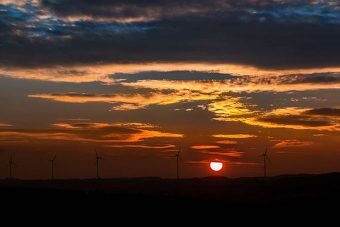
By the end of this century, global climate change may impact the wind resources in many regions of the Northern Hemisphere, decreasing hotspots in the North but increasing hotspots in the Southern Hemisphere, according to a new study from researchers at the University of Colorado Boulder.
The new research, published in the journal Nature Geoscience, investigates the potential impact of climate change on global wind resources. While shifts in wind patterns is concerning enough, the study has massive implications for the wind energy industry, which often bases its wind energy resource estimates on today’s current climate, rather than taking into account the potential shifts climate change will have on these same resources.
The researchers from the University of Colorado Boulder applied “an industry wind turbine power curve to simulations of high and low future emissions scenarios in an ensemble of ten fully coupled global climate models to investigate large-scale changes in wind power across the globe.” Their calculations are disturbing, revealing wind resources decreasing across the Northern Hemisphere mid-latitudes and increases in wind resources across the tropics and Southern Hemisphere, “with substantial regional variations.”
“There’s been a lot of research looking at the potential climate impact of energy production transformations — like shifting away from fossil fuels toward renewables,” said lead author Kris Karnauskas, CIRES Fellow and Assistant Professor in Atmospheric and Oceanic Sciences (ATOC) at CU Boulder. “But not as much focuses on the impact of climate change on energy production by weather-dependent renewables, like wind energy.”
For example, the American Midwest is littered with wind farms with tens of thousands of wind turbines. The new research shows that wind power production in this area over the next 20 years would be similar to that of today, but that by the end of the century it could drop. Conversely, the potential wind energy resources in northeastern Australia could increase significantly.
The reasons for these decreases and increases are not the same, however. Warmer temperatures in the Northern Hemisphere at the North Pole weaken the temperature difference between the cold north and warmer equator, and a smaller temperature gradient means slower winds in the northern mid-latitudes. Similar wind resource decreases could occur in Japan, Mongolia, and the Mediterranean by the end of this century.
Conversely, in the Southern Hemisphere, where there is a lot more water than there is land, a different kind of gradient increases wherein land warms faster than the surrounding oceans — just imagine Australia, lots of land surrounded by even more water. The intensified gradient increases the winds, and new hotspots could crop up in areas like Brazil, West Africa, South Africa, and Australia.
“Europe is a big question mark,” said Karnauskas. “We have no idea what we’ll see there. That’s almost scary, given that Europe is producing a lot of wind energy already.”
“The climate models are too uncertain about what will happen in highly productive wind energy regions, like Europe, the Central United States, and Inner Mongolia,” added co-author Julie Lundquist. “We need to use different tools to try to forecast the future — this global study gives us a roadmap for where we should focus next with higher-resolution tools.”
The models created by the researchers did not necessarily all agree on what the future will look like, except to conclude that substantial changes are likely. But those changes will not necessarily be equally spread out. If carbon dioxide emissions continue at high levels without mitigation, then wind power resources may decrease in the Northern Hemisphere’s mid-latitudes and increase in the Southern Hemisphere and tropics. But if emission levels are mitigated somewhat, wind resources drop in the North but do not necessarily increase in the South.
Source: cleantechnica.com



